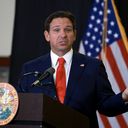What to know about the H-1B visas fueling divide in MAGA world
An erupting civil war in MAGA world over foreign workers has shone a fresh spotlight on a visa scheme that has become the backbone of the country's highly-skilled tech industry.
Why it matters: The brewing conflict has underscored the schism between one of President-elect Trump's cornerstone pledges — cracking down on immigration — and his Silicon Valley supporters, many of whose businesses depend on attracting foreign workers.
Between the lines: No one epitomizes the fracture among the MAGA movement more than Elon Musk, who has become one of Trump's most influential and prominent backers.
- Musk, a South African immigrant who previously held the coveted H-1B visa and whose businesses rely on attracting the best engineering talent around the world, has emerged as one of the most vocal defenders of the H-1B visa program.
- Yet other MAGA figures like far-right activist Laura Loomer have maintained a more hardline immigration stance, arguing the U.S. should prioritize American workers over foreign ones.
State of play: The brewing conflict among Trump's supporters also highlighted the racial tensions in the MAGA tent.
- Largely white, working-class voters spurred Trump's political rise nearly a decade ago, while the current clash revolves around the admittance of primarily non-white, highly skilled workers into the U.S.
Here's what to know about the H-1B visa program fueling the divide in MAGA world.
What is the H-1B visa scheme?
The H-1B visa allows for highly skilled workers in "specialty occupations" to live and work in the U.S. under a "nonimmigrant status."
- It enables American companies to employ foreign workers that have highly-specialized theoretical or technical skills.
- Proponents argue the program allows the U.S. to retain a competitive edge in STEM fields by attracting the most highly skilled professionals worldwide.
How does it work?
H-1B applicants must have a bachelor's degree or equivalent in a field relevant to their specialty occupation.
- Approval for the visa requires sponsorship from a prospective employer, who must file a petition with the U.S. Citizenship and Immigration Services (USCIS).
- In the petition, the employer attests that they will appropriately pay the foreign worker and that their employment won't negatively impact "similarly employed" U.S. workers.
Zoom in: H-1B visas are typically granted for up to three years, but can be extended for no more than six years total.
- Because the program grants "nonimmigrant status" to recipients, it means the workers' stay in the U.S. is conditioned as temporary. The H-1B is not an immigration visa, with a path toward permanent residency.
Who gets H-1Bs?
The U.S. government caps the approval of new H-1B visas at 85,000 per year.
- A March report from the Department of Homeland Security found that 72% of H-1B recipients between Oct. 2022 and Sept. 2023 were from India.
- The second-most common country of origin was China, with nearly 12% of recipients. The third was the Philippines, at just over 1% of beneficiaries.
- 71% of H-1B recipients were men, per the report.
Where does the H-1B program fit in Trump's agenda?
Trump's election victory has spurred worries among many immigrants that Trump could again attempt to restrict the H-1B program, NBC News reported.
- During his first term, Trump issued a temporary freeze on H-1B visas and later issued new restrictions on the H-1B program, though some of these rules were later struck down in court.
- A representative for the Trump transition did not immediately respond to Axios' request for comment regarding the president-elect's plans for the H-1B visa during his second term.
Go deeper:







































